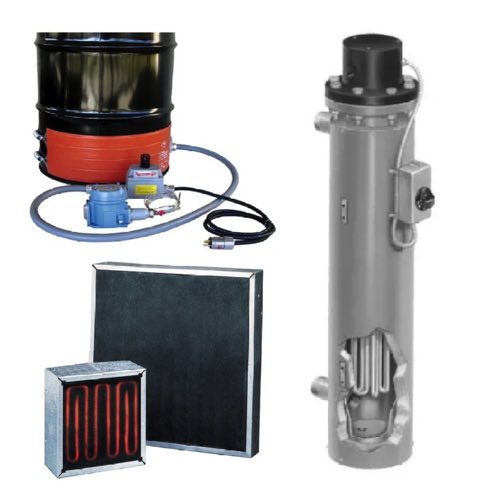Heaters

Heaters are designed to deliver precise, reliable thermal control across a wide range of industrial and laboratory applications. Our product lineup includes cartridge heaters, flexible heaters, band heaters, immersion heaters, and strip heaters, These heating solutions are engineered for accuracy, durability, and versatility. They are built to withstand demanding environments and are often customizable to meet the specific requirements of temperature ranges, wattage, and installation types for a variety of systems.
Heaters incorporate advanced materials and construction techniques to enhance performance and longevity. For instance, flexible heaters are made with rugged silicone rubber or polyimide film, allowing them to conform to complex shapes and surfaces while providing even heat distribution. Cartridge and immersion heaters are designed with high-grade stainless steel or Incoloy sheaths, ensuring excellent corrosion resistance and mechanical strength in harsh or corrosive environments. Many heaters also feature integrated sensors for closed-loop temperature control, enabling precise monitoring and adjustments to maintain optimal heating conditions.
Analog and Digital Control Signals: The Basics
Digital Signals
Digital signals are represented in either a true or false. There is no gray area with digital signals. An example of this might be a light switch. A light switch is either on or off. Another example of this might be a motor that is running or not running. Digital signals can be generated with both AC and DC circuits with varying voltages, currents and resistance. Some practical examples of using digital signals in an industrial environment might be if a pump is running or not running or a whether a valve is open or closed.
Analog Signals
Analog signals convey information in the form of a range. A light switch might be on or off as a digital signal, but a dimmer switch would be an analog signal. It can be on or off, but it can also be somewhere in between. A practical example of using analog signals in an industrial environment would be if there is a need to measure the level of a tank; whether it's full, empty or somewhere in between. Analog signals can take many different forms with some of the more common being a 4 to 20 milliamp signal or a 0 to 5 or 0 to 10 volt signal.
Communication
Communication in a device can either be sent or received. Whether that data is sent or received depends on the type of information. Is there a need to monitor the status of something? If so, an input needs to be received about that information. Is there a need to control something? If so, an output needs to be sent about what needs to occur. Receiving inputs and setting outputs are both things that can be accomplished by using both digital and analog signal types. Therefore, the signals are referred to as analog outputs (AO), analog inputs (AI), digital inputs (DI) or digital outputs (DO).

